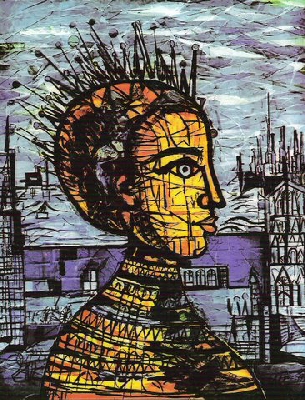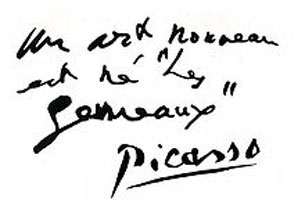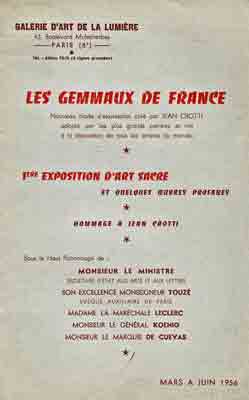Gemmail : the Art of light

Gemmail by Carzou Fille de Carthage 1976
Gemmail
A new form of expression which brings together electric light and coloured glass of varying thickness ( sometimes up to five centimetres thick ), fragments of which are laid on top of each other in order to obtain a wide variety of colours, hues, and movements.

History
This technique was invented by the artist Jean CROTTI in 1935, when he wanted to light up a decorative panel, made up of fragments of glass. He consulted a researcher of physics, Christian Malherbe-Navarre, who was familiar with techniques related to light and electricity. It took until 1950 for the technique to be perfected.
Technique
The gemmist is guided by the maître d'oeuvre who directs the proceedings from the top of a ladder.The artist works on large sheets of glass which are placed on tressels.They are illuminated from underneath. Then, the different coloured fragments of glass, of varying degrees of thickness are laid on top of each other depending on the colours and tones the artist wants to obtain. They are temporarily stuck together using transparent glue.
After that, the artist, and the maître d'oeuvre inspect the work. If they are satisfied with it, it is signed by the artist, and the work is placed in a drying kiln where the glue is removed. Next, the fragments of glass are stuck together permanently, using a special glue developed by the inventer, the recipe of which is kept secret. The work is then put into another kiln, where the temperature is increased slowly and carefully in order to avoid any damage to the work. In the same way, the final cooling is carefully controlled.
The gemmaux are all UNIQUE pieces of work, and each has a certificate of authenticity which is signed and numbered.
Braque la lampe sur la table ( lamp on table ), le port de la Ciotat ( Ciotat Harbour ), Aquarium sur une caisse l'Estaque ( Aquarium on Estaque box ) 58 x 60 cm
Jean Cocteau Orphée attaqué( Orpheus attacked ), Orphée avec feuillages ( Orpheus with leaves )Matisse, Picasso Le paysage de nuit ( landscape at night ), M. de Soto, Mère et enfant ( mother and child ), Femme assise dans un fauteuil ( woman in an armchair ) 99.5 x 76 cm, La femme aux pigeons ( woman and pigeons ), Les adolescents ( teenagers ), Deux femmes ( two women ), Nature morte à la tête antique ( still life with antique head ), Van Dongen, Fernande, Vlaminck, les bateaux-lavoirs ( the wash-houses ). By adding their signature to the pieces, all these works greatly contributed to the success of this new kind of art.
1957 : Creation of an annual International gemmail prize, awarded to the " painter of light ".
1963 : Setting up of a Museum of Gemmail in Tours 7 rue du Mûrier 37000 Tours
Tel 024760 0119
1969 : Bienniale of Sacred art in Lourdes and the setting up of a Museum of Sacred Art
72 rue de la Grotte 65100 Lourdes Tel 056294115 where 50 gemmail pieces are on display.
Others award-winning works
1957 : Danielle DHUMEZ Le port de lumière ( Port of light ) - 1967 : Yves BRAYER Le héron cendré ( grey heron ) - 1968 : Pierre AMBROGIANI - 1970 : TOFFOLI Intimité mexicaine ( Mexican intimity ) -1971 : AÏZPIRI La Dame de Cour - 1972 : André MARCHAND - 1973 : Michel CIRY - 1975 : JANSEM -1976 : Jean CARZOU Fille de Carthage ( Girl from Carthage ) - 1978 : Jean COMMERE L'enfant sauvage ( wild child ) - 1979 : CHAPELAIN-MIDY - 1980: Jacques VOYET Le marin ( the mariner ) - 1981: Pierre HENRY Le pain et le vin ( bread and wine ) - 1986 : BRICKA Maternité 1988 : René MARGOTTON. le vase grec 1991 : PIER LE COLAS Regina Pacis - 1993: MURYAMA Le printemps de Loire ( Loire springtime ) - 1994 : Michel CIRY Adieu de Jésus à Marie (Jesus bids Mary good-bye) - 1996 : Michel HENRY Le jardin de France (The garden of France - 1998 : Jean DAPRAI Effets de serres ( Greenhouse effect ) - 1999 : Guy GAMBIER : Que ta volonté soit faite (Thy will be done)
Article from Le Gemmail, Art de la Lumière. Expression du XX° siècle.
Catalogue 21 x 29,5 cm, undated, 24 pages, pages not numbered

Les Gemmaux de France March to June 1956